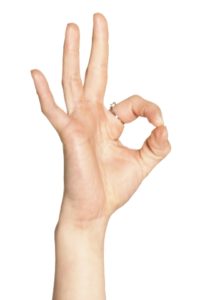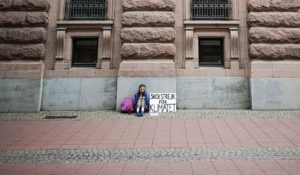 A recent media account discusses the addition of a number of hate symbols to the Anti-Defamation League’s database, “Hate on Display” . Those include images and logos used by white supremacist groups, such as the Rise Above Movement from Southern California or the recently-formed American Identity Movement. The surprising addition to the list, however, was a commonly used hand gesture, the “ok” sign, forming a circle by connecting the index finger to the thumb, with the other fingers spread out. In some communities, especially online, that gesture has become associated with white supremacy and the far right (outstretched fingers as “W”, the circle and hand as “P”, for “White Power”). That apparently had its origin in a prank by users of the 4chan website in 2017, then consolidated by the use of the gesture by the Christchurch, NZ shooter who killed 51 people at two mosques in March.
A recent media account discusses the addition of a number of hate symbols to the Anti-Defamation League’s database, “Hate on Display” . Those include images and logos used by white supremacist groups, such as the Rise Above Movement from Southern California or the recently-formed American Identity Movement. The surprising addition to the list, however, was a commonly used hand gesture, the “ok” sign, forming a circle by connecting the index finger to the thumb, with the other fingers spread out. In some communities, especially online, that gesture has become associated with white supremacy and the far right (outstretched fingers as “W”, the circle and hand as “P”, for “White Power”). That apparently had its origin in a prank by users of the 4chan website in 2017, then consolidated by the use of the gesture by the Christchurch, NZ shooter who killed 51 people at two mosques in March.
That certainly does not mean that anyone using the gesture is a white supremacist. The usage and cultural context will determine both intent of the user and the message received. In the US in most contexts, the gesture will likely continue to be understood as “that’s fine” or “a-ok”. However, in other countries that gesture has had different meanings. In Germany, for example, the gesture has a vulgar meaning (representing the human anus) traditionally equating to “you’re an asshole”. In Japan and other cultures, the gesture is used to symbolize money (i.e. representing a coin), or to ask for a bribe. In France, the symbol has been interpreted as zero, thus transmitting the meaning as worthless. In some Arab cultures, it represents the evil eye, therefore used as a curse. Complicating those meanings, however, is the wide influence of US culture through popular media, so that in some cases, especially among younger people, the gesture may be used in accordance with US mainstream culture. That phenomenon has been seen in the spread of other gestures as well, such as the middle finger as an insult gesture. How the gesture is intended will likely be signaled through other indicators, such as facial expressions or body language.
Another interesting hate symbol added to the ADL’s list is a hair cut: the “bowlcut“, a style that looks like a bowl was used in cutting someone’s hair, as in the early Beatles’ look. In this case, however, the reference is to another white supremacist, Dylann Roof, responsible for the attack at the Emanuel AME Church in Charleston, South Carolina in 2015. Other white supremacists have referenced Roof’s haircut by using screen names that incorporate the world “bowl” or use the word in catch phrases. According to the ADL,
Roof promoters also create and share Roof-related memes across the Internet, including depictions of Roof as a saintly figure with a halo around his head. Even more common are memes featuring Roof’s bowl haircut, either by itself or digitally affixed to other people’s heads. In one shared image, Roof’s haircut has been superimposed on a shield designed to resemble the divisional insignia of Waffen SS military units of Nazi Germany.
Other hair styles have been associated with white supremacy as well, namely mohawks and especially shaved heads, known as skinheads. That shows the importance for members of groups (especially traditionally outlier groups) to show group adherence through explicit symbols, dress, or other aspects of personal appearance.

